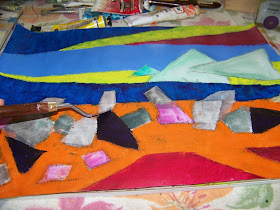After making the original drawing, I would use Inktense blocks to lay down an initial colour for an underpainting, to establish the tonal values of the painting.
This is the landscape photo I would be working from on the computer screen. I will post a few more photos at the end of the blog, which you may feel free to use for your own paintings.
I opted to work on paper and chose Rolfes Gouache paper as my surface.
The paper has a repetitive grain of small holes. You will either hate it, or love it. Artists tend to be divided on this issue.
I use charcoal to draw my original sketch. Note how I've dealt with the clouds in the sky. The landscape has also been reduced to lines where water and land meet. The trees and shrubs have been turned into triangles and the rocks in the foreground have been given odd geometric shapes.
I brush the darkest charcoal powder away with a brush and leave myself a much lighter outline to work from.
I then use Inktense to paint the indertones of the drawing. I love using Inktense rather than watercolours, as the colour is fixed once dry, where as water colours can be lifted again when re-whetted.
Once dry, I paint the first colour with a palette knife. I use very thin layers of paint and scrape the excess paint away with the palette knife.
I move well away from natural colours, opting to rather paint the emotion of the day, than the natural colours. In other words, I manage to portray my own joyous feelings about being there, in the painting.
The third colour I add is even warmer and brighter than the previous.
I add a calming blue to the scene. This is one of only a few colours I used that were not transparent. The transparent colours were all affected by the underpainting. The opaque colours were free of this interference. Bear this in mind in your own painting as well.
Some colours will need to repeat to satisfy the eye. As the colours are affected by the underpainting, it would not be a definitive repetition of colours, making the painting slightly more interesting than it would have been otherwise.
I then allow the water to reflect at least part of the sky.
I opt to use a very vibrant and optimistic orange where I was ran around, fascinated by the myriad of different stones and rocks.
I gave free reign to my emotional experience when choosing these bright and happy colours in the foreground.
Even bright colours need to be cooled down and I achieved this by adding purple, which is a compromise on blue.
Be sure to repeat the colours of the rocks as there certainly will always be more rocks than one, of every type, in any location.
Add enough cool colour to balance a warm painting. You do not wish to overwhelm your viewers.
Some neutral colours are always a good idea, even in an abstract work.
Continue adding colours until you are satisfied with the results.
I kept the colours on the trees and shrubs more natural to ground the painting a little.
I only made sure that I used three distinct shades of green.
The finished painting is far removed from the original. but manages to convey my feelings brilliantly. It speaks of a simpler life which has been stripped of its intricacies and hardships. It also conveys a positive and happy experience through the liberal use of bright colours. Is it my favourite painting? No. Did it achieve to communicate what I wanted to say? Yes. That is important. Art is a means of communication and this picture speaks my language. Be sure to look out for more photo references to use at the end of the blog.
Marietjie Uys (Miekie) is a published author. You can buy the books here:
You can purchase Designs By Miekie 1 here.
Jy kan Kom Ons Teken en Verf Tuinstories hier koop.You can purchase Designs By Miekie 1 here.
Jy kan Kom Ons Kleur Tuinstories In hier koop.
Jy kan Tuinstories hier koop.
You can follow Miekie's daily Bible Study blog, Bybel Legkaart, here in English & Afrikaans.
For more crafty ideas and great products, visit A Pretty Talent on Facebook.
Remember to keep nurturing your TALENT for making PRETTY things.
You can subscribe to this blog and receive regular updates by email by simply registering your email address at the top of the current blog.



































No comments:
Post a Comment